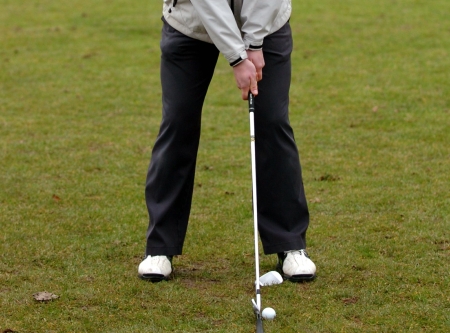Best Way to Practice Your Long Chip-And-Run Shot
This type of shot is often called for during a round of golf, so your game will benefit if you practice it regularly. For some reason, many golfers consider this an easy shot, so their concentration is not always as sharp as it should be, resulting in poor visualisation and a lack of success. When they have a difficult chip to play, they concentrate more, and their improved visualisation as a rule leaves the ball only 2 or 3 yds/m from the flag. But the normal long chip-and-run shot, easy as it seems to execute, needs the same sharpness, otherwise you will find yourself too far from the flag to have a reasonable chance of finishing off with a single putt.
Therefore, always use your imagination before choosing the club and type of shot to be played. Use the same pre-shot routine as always; seeing a successful result with your practice swing is a must.
Varv the lie of the ball, not forgetting uphill and downhill shots. Compete with yourself and see how many times out of ten the ball lands in the chosen area and how many times it rolls the correct distance. Vary your choice of club and swing length in order to create feedback. Remember this is the golf swing in miniature. The correct execution of this shot will enhance your chances of swinging the club correctly when you come to use the half, three-quarter and full swing movements.
Practicing the two-levered chip
Taking about ten balls on to the practice ground, pick a suitable target area where you want the ball to land if you play it with your No. 9 iron. In this example, the area is about 25 yds (23 m) away.
- Take your practice swings to gauge the length of swing required to play the ball 25 yds (23 m).
- The address position with the No. 9 iron: ball in the centre of the stance, weight favouring the left side, and hands just in front of the ball. Light grip pressure.
- On the backswing, the wrists cock slightly due to the light grip and the length of the swing,
- The ball is struck and on its way. Note how the triangle formed by the arms and shoulder line is maintained all the way. shot length.
- Hold the follow-through position to get feedback concerning the length of swing you used to achieve this
Categories
Advertisements
Recent Articles
 How to Understand Bed Sizes – A Small Guide
How to Understand Bed Sizes – A Small Guide How to Select Some Must Have Kitchen Accessories
How to Select Some Must Have Kitchen Accessories Best Way to Change a Car Tire
Best Way to Change a Car Tire Best Way to Write an Affirmation
Best Way to Write an Affirmation Best Way to Take Charge of Your Financial Life
Best Way to Take Charge of Your Financial Life Best Way to Survive a Party When You Don’t Know Anyone
Best Way to Survive a Party When You Don’t Know Anyone Best Way to Stop Self Sabotaging Yourself
Best Way to Stop Self Sabotaging Yourself Best Way to Start Journal Writing
Best Way to Start Journal Writing Best Way to Speak with a Powerful Voice
Best Way to Speak with a Powerful Voice Best Way to Simplify Your Life
Best Way to Simplify Your Life Best Way to Respond to a Put-Down
Best Way to Respond to a Put-Down Best Way to Reduce Acne Breakouts
Best Way to Reduce Acne Breakouts Best Way to Recover from Dining Disasters
Best Way to Recover from Dining Disasters Best Way to Quit Your Job Gracefully
Best Way to Quit Your Job Gracefully Best Way to Make Your Own Website
Best Way to Make Your Own Website



Leave a Reply